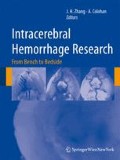Abstract
Intracerebral hemorrhage (ICH) causes severe brain injury in aged rats. Autophagy occurs in the brain after ICH, and the present study examined the effects of aging on autophagy after ICH. Aged (18–22-month) and young (4–6-month) male Fischer rats received an intracerebral injection of 100-μL autologous whole blood. Rats were killed at day 7 for Western blot analysis to measure microtubule-associated protein light chain-3 (LC3), a biomarker of autophagosome, and cathepsin D, a lysosomal biomarker. Rats were killed at 11 weeks after ICH for brain histology. Age-related changes in neurological deficits were also examined. Western blotting showed that the LC3-I/LC3-II conversion ratio in the ipsilateral basal ganglia was higher in aged compared to young rats (p < 0.05). Perihematomal cathepsin D levels were also higher in aged rats (p < 0.05). Neurological deficits after ICH were more severe in aged rats, and they had a slower recovery of function (p < 0.05). In addition, there were more ferritin and OX-42 positive cells in the ipsilateral basal ganglia in aged than in young rats 11 weeks after ICH (p < 0.05). Brain atrophy was found in both young and aged rats. In conclusion, ICH causes more severe autophagy and neurological deficits in aged rats.
Access this chapter
Tax calculation will be finalised at checkout
Purchases are for personal use only
References
Gong Y, Hua Y, Keep RF, Hoff JT, Xi G (2004) Intracerebral hemorrhage: effects of aging on brain edema and neurological deficits. Stroke 35:2571–2575
He Y, Wan S, Hua Y, Keep RF, Xi G (2008) Autophagy after experimental intracerebral hemorrhage. J Cereb Blood Flow Metab 28:897–905
Kabeya Y, Mizushima N, Ueno T, Yamamoto A, Kirisako T, Noda T, Kominami E, Ohsumi Y, Yoshimori T (2000) LC3, a mammalian homologue of yeast Apg8p, is localized in autophagosome membranes after processing. EMBO J 19:5720–5728
Yan L, Vatner DE, Kim SJ, Ge H, Masurekar M, Massover WH, Yang G, Matsui Y, Sadoshima J, Vatner SF (2005) Autophagy in chronically ischemic myocardium. Proc Natl Acad Sci USA 102:13807–13812
Koeppen AH, Dickson AC, McEvoy JA (1995) The cellular reactions to experimental intracerebral hemorrhage. J Neurol Sci 134:102–112
Wu J, Hua Y, Keep RF, Nakamura T, Hoff JT, Xi G (2003) Iron and iron-handling proteins in the brain after intracerebral hemorrhage. Stroke 34:2964–2969
Schwartz M (2003) Macrophages and microglia in central nervous system injury: are they helpful or harmful? J Cereb Blood Flow Metab 23:385–394
Wu J, Yang S, Xi G, Song S, Fu G, Keep RF, Hua Y (2008) Microglial activation and brain injury after intracerebral hemorrhage. Acta Neurochir Suppl 105:59–65
Xi G, Keep RF, Hua Y, Xiang JM, Hoff JT (1999) Attenuation of thrombin-induced brain edema by cerebral thrombin preconditioning. Stroke 30:1247–1255
Hua Y, Schallert T, Keep RF, Wu J, Hoff JT, Xi G (2002) Behavioral tests after intracerebral hemorrhage in the rat. Stroke 33:2478–2484
Tolkovsky AM, Xue L, Fletcher GC, Borutaite V (2002) Mitochondrial disappearance from cells: a clue to the role of autophagy in programmed cell death and disease? Biochimie 84:233–240
Yu L, Alva A, Su H, Dutt P, Freundt E, Welsh S, Baehrecke EH, Lenardo MJ (2004) Regulation of an ATG7-beclin 1 program of autophagic cell death by caspase-8. Science 304:1500–1502
Wu G, Xi G, Hua Y, Sagher O (2010) T2* magnetic resonance imaging sequences reflect brain tissue iron deposition following intracerebral hemorrhage. Transl Stroke Res 1:31–34
Xi G, Keep RF, Hoff JT (2006) Mechanisms of brain injury after intracerebral haemorrhage. Lancet Neurol 5:53–63
Streit WJ, Walter SA, Pennell NA (1999) Reactive microgliosis. Prog Neurobiol 57:563–581
Streit WJ, Sparks DL (1997) Activation of microglia in the brains of humans with heart disease and hypercholesterolemic rabbits.[comment]. J Mol Med 75:130–138
Wu J, Yang S, Xi G, Fu G, Keep RF, Hua Y (2009) Minocycline reduces intracerebral hemorrhage-induced brain injury. Neurol Res 31:183–188
Acknowledgment
This study was supported by grants NS-017760, NS-039866 and NS-057539 from the National Institutes of Health (NIH) and 0755717Z, 0840016N from the American Heart Association (AHA). The content is solely the responsibility of the authors and does not necessarily represent the official views of the NIH and AHA. Drs. Gong and Gu were supported by NSFC30872675 and NSFC30700864 from the China National Natural Science Foundation.
Conflict of interest statement We declare that we have no conflict of interest.
Author information
Authors and Affiliations
Corresponding author
Editor information
Editors and Affiliations
Rights and permissions
Copyright information
© 2011 Springer-Verlag/Wien
About this chapter
Cite this chapter
Gong, Y., He, Y., Gu, Y., Keep, R.F., Xi, G., Hua, Y. (2011). Effects of Aging on Autophagy After Experimental Intracerebral Hemorrhage. In: Zhang, J., Colohan, A. (eds) Intracerebral Hemorrhage Research. Acta Neurochirurgica Supplementum, vol 111. Springer, Vienna. https://doi.org/10.1007/978-3-7091-0693-8_18
Download citation
DOI: https://doi.org/10.1007/978-3-7091-0693-8_18
Published:
Publisher Name: Springer, Vienna
Print ISBN: 978-3-7091-0692-1
Online ISBN: 978-3-7091-0693-8
eBook Packages: MedicineMedicine (R0)

